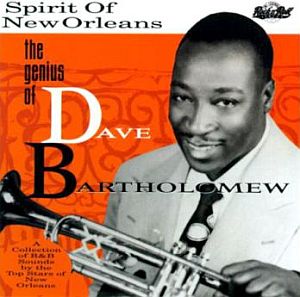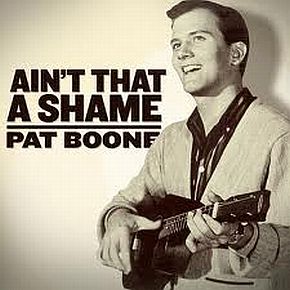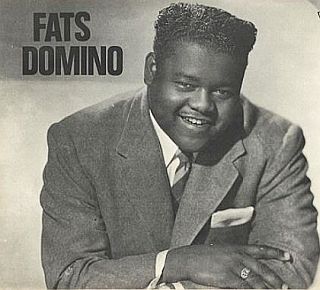
Fats Domino photo from a 1950s record sleeve for “There Goes My Heart Again” and “Can’t Go On Without You.” Click for digital.
In 1949, Domino recorded a song titled “The Fat Man” on Imperial Records that became a No. 1 hit on the R&B chart in 1950. That recording is regarded as one of the earliest rock `n roll songs, featuring a rolling piano along with Domino’s vocals. “The Fat Man” would sell one million copies by 1953.
But there’s a lot more to Fats Domino than his first hit record. According to the Rock and Roll Hall of Fame, between 1950 and 1963, Domino made Billboard’s pop chart 63 times and the R&B chart 59 times. In fact, notes the Hall, “Domino scored more hit records than Chuck Berry, Little Richard and Buddy Holly put together”(emphasis added).
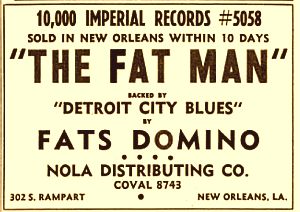
January 1950 ‘Billboard’ magazine ad for Fats Domino’s first record, boasting “10,000...sold in New Orleans within 10 days”; would become a million-seller hit. Click for digital.
As an ice delivery man in New Orleans for a time, with bars and nightclubs among his customers, Domino would sometimes slip away to play on pianos he found at those stops. He also worked for a time in a bed spring factory, playing honky tonks at night.
But it was at the Hideaway Club in New Orleans where house band leader Bill Diamond gave him the nickname “Fats,” as Domino reminded him of another famous piano player, Fats Waller. Domino, meanwhile, persisted with his piano playing and soon had the help of some street-wise business musicians.
A key partner to Fats Domino was Dave Bartholomew, a New Orleans trumpeter, songwriter, and pioneering R&B producer. Bartholomew’s collaborations with, and guidance for the young Domino, would have the most profound impact on his career.
Bartholomew was also an arranger and bandleader, and he and Fats co-wrote and produced most of Domino’s hits. It was Bartholomew who brought Lew Chudd of Imperial Records to the Hideaway Club to hear Domino play his boogie woogie piano, and some of his specialty songs such as “Swanee River Boogie” and “Junker’s Blues.” Chudd liked what he heard and signed Domino on the spot.
Two weeks later, Domino made his first recording, “The Fat Man,” noted earlier, which rose to No. 1 on the R&B charts in February 1950. For the next five years, Domino, and mostly Bartholomew’s band, recorded a steady stream of R&B hits for Imperial Records.
Among these were: “Every Night About This Time,” a Top Ten, October 1950 R&B hit; “Goin’ Home,” his first No. 1 R&B hit in 1952, (which Fats recorded with his own band); and three more Top Ten R&B hits in 1953, including: “Going To the River”, “Rosemary”, and “Please Don’t Leave Me.”
Music Player
“Please Don’t Leave Me” – Fats Domino
Some of Domino’s early hits, such as “Please Don’t Leave Me,” and others of that vintage, were not meant to be lyrical wonders, but rather, more rhythmic, featuring his signature boogie woogie piano style and “the big beat,” as it was called. And as such these songs became very popular dance tunes, and eventually would bring a wide teen following.
Throughout the process, Fats and Dave Bartholomew were innovating as they went. In fact, American rock critic, Robert Christgau, writing for The Village Voice some years later, would credit Fats and Bartholomew as having “defined a pop-friendly second-line beat that nobody knew was there.”
In Domino’s rising career, he would join some traveling musical reviews that performed beyond Louisiana. On August 1, 1954, for example, he joined Cleveland disc jockey Alan Freed’s “Moondog Jubilee Of Stars Under the Stars,” held at Brooklyn’s Ebbets Field, then still home of baseball’s Brooklyn Dodgers. On the bill at the Freed concert, in addition to Domino, were the Clovers, the Orioles, Little Walter, Muddy Waters, Count Basie’s Orchestra, and Buddy Johnson’s Orchestra. A large, racially mixed crowd came out for this concert, like others Alan Freed had organized, giving broader exposure to artists like Domino, who by this time was becoming more widely known. In fact, five of his records released before 1955 had already sold over a million copies and would become certified gold records. But Fats’ first national breakthrough came in the summer of 1955.
First Pop Hit
Domino’s first pop hit and first “crossover” success — as R&B songs moving to the mainstream white pop charts were termed in those days – came in July 1955. The song’s title was “Ain’t That A Shame.” It was a Top Ten pop hit; the first hard-rocking black record to cross over. However, its rise on the pop charts for Domino came in a round about way. Fats had recorded “Ain’t That A Shame” at an earlier 1955 studio session in Los Angeles.
Music Player
“Ain’t That A Shame” – Fats Domino
However, within a week of Domino’s initial recording, a white movie star named Pat Boone also recorded a version of the same song. Boone, then something of heart throb among teen girls because of his movies, was not then a successful singer, although he had cut one recording that did poorly a year earlier. Still, Boone’s managers thought he might have some success in that arena given his film exposure.
In any case, Boone’s version of the Domino song (click for YouTube) charted in July, and soon became a No. 1 hit – his first. Boone’s version of “Ain’t That A Shame” stayed in the Top 40 for 20 weeks. And according to one source, that set the stage for the early part of Boone’s singing career, which then focused on covering R&B songs for the white American market.
Yet the Boone version of “Ain’t That A Shame” – arriving on the pop charts first – apparently didn’t hurt Domino’s version, which hit the pop charts shortly after Boone’s did, in mid-July 1955, and rose to No 10. Domino’s version — which also hit No.1 on the R&B chart — stayed in the Top 40 for 13 weeks. However, between the two versions, since Domino and Bartholomew were the authors of the song and collected publisher’s fees, the two had a pretty good payday thanks in part to Boone’s successful No. 1 version, as well as their own. Domino, all in good fun, reportedly complimented Boone on his cover of the song. And on one later occasion, at a concert where Domino invited Boone on stage, Domino showed off a big gold ring he was wearing, making the comment: “Pat Boone bought me this ring.”
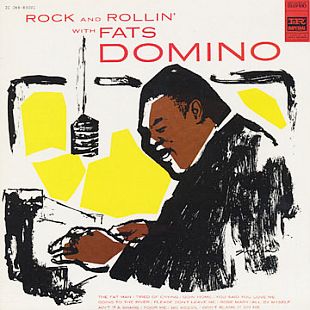
Fats Domino’s first album, here in its re-issued title & cover art of 1956, captured a number of his early R&B hits. Click for album.
In 1955, Domino also had three other No. 1 R&B hits – “All By Myself,” “Poor Me,” and “I’m In Love Again.” His debut album, Carry On Rockin, was released on the Imperial Records label in November 1955 and subsequently reissued as Rock and Rollin’ With Fats Domino in 1956. The reissued album, combining a number of his hits along with others not then released, rose to No. 17 on the pop albums chart. But Fats was headed for additional fame in 1956 as his music spread around the country, and as he appeared as a performer. His music was also being called “rock `n roll” by then.
“Everybody started calling my music rock and roll,” Domino would later say, remarking on his early success in the 1950s. “But it wasn’t anything but the same rhythm and blues [R&B] I’d been playin’ down in New Orleans.”
Fats had a likeable demeanor about him when he performed. Basically a shy man, and not inclined toward the showmanship-type style of Jerry Lee Lewis or an Elvis Presley, Fats always gave a friendly smile to his audience and viewers as he performed. His upbeat tunes and boogie-woogie rockers, however, could sometimes bring out the energy and exuberance of young dancers and audiences – and not always in a good way.
Raucous Crowds
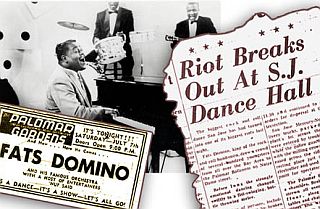
July 1956: Some rioting broke out at a Fats Domino show in San Jose, California at the Palomar Gardens Ballroom.
On Saturday, July 7th, 1956 Fats was scheduled to perform at the Palomar Gardens Ballroom in San Diego, California. Management there expected that the Palomar Gardens crowd for Domino would be one of its largest ever. Some 3,500 tickets were sold for that concert, and lines of people wrapped around six blocks. But that performance, it turned out, was also one of the earliest “rock and roll riots” in America. Some beer bottles were thrown and windows were broken; clothes were ripped and fist fights erupted; and some people were taken to the hospital. San Diego wasn’t alone, however. On September 18th, 1956, rock music shows were banned at the U.S. Naval Station in Newport, Rhode Island after a fight broke out during a Fats Domino concert.
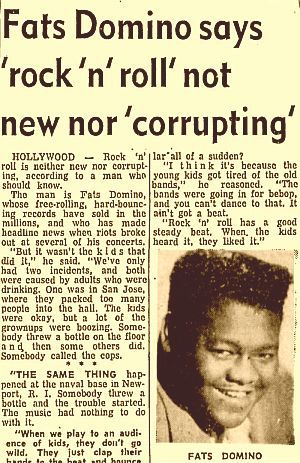
1950s newspaper account interviewing Fats Domino about “riots” at his performances.
All told that year, there were at least four major “riots” at Domino’s shows. The raucous behavior at these concerts set off a wave of reaction from concerned parents, politicians, psychiatrists, and journalists, all now raising questions about the dangers of this explosive music called “rock and roll.”
Some wanted to blame the music, but when Domino was asked that question he would always reply that the music wasn’t the cause of the wild behavior, especially among the younger kids who were dancing. Asked by a reporter on camera whether rock ‘n roll could be blamed for rioting, Domino answered, “Well, as far as I know, music makes people happy.” As the reporter fired back with another question, this time about the rioting at the Rhode Island naval base, Domino smiled and said, “Well you know when the Navy and the Marines get together…”
The problems that occurred were usually due to alcohol-fueled incidents, and not the music. And in some locations, there were also racial tensions.
“He [Domino] had four major riots at his shows partly because of integration,” says Domino biographer, Rick Coleman, who also noted that alcohol was a factor at these shows. “So they were mixing alcohol, plus dancing, plus the races together for the first time in a lot of these places.” But Coleman finds a positive note at Fats Domino’s and others road shows during this era. “There was this historic moment in American history,” says Coleman. “That things were kinda coming together and people don’t really credit rock ‘n’ roll for integrating America, but it really did.” However, although music may have been a helpful contributor and door opener, full integration and full equality would still be years away.
Film & TV
Fats Goes National
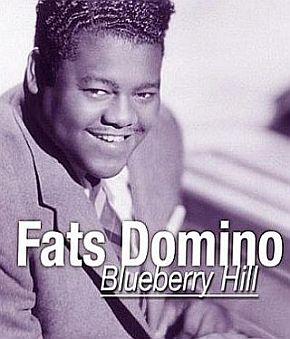
Fats Domino, on a record cover for “Blueberry Hill,” a 1956 song for which he became most famous. Click for digital.
Music Player
“Blueberry Hill” – Fats Domino
“Blueberry Hill” was originally written in 1940, and had early versions recorded by big band leader Glenn Miller, cowboy singer Gene Autry, and jazz legend Louis Armstrong, among others. But in October 1956, “Blueberry Hill” became a giant Fats Domino hit. It rose to No. 2 on the pop charts and No. 1 on the R&B charts, where it held for 11 weeks.
On November 18th, 1956, Domino appeared on the nationally-televised Ed Sullivan Show singing “Blueberry Hill” by himself at the piano, while the rest of his band was hidden. The Fats Domino version of “Blueberry Hill” – which became his signature song – would sell more than five million copies worldwide in 1956–57 and would remain Domino’s biggest hit. In December 2004, Rolling Stone magazine ranked it at No. 82 on its list of of “The 500 Greatest Songs of All Time”
Domino biographer Rick Coleman, cites Gerald Early, author of One Nation Under a Groove, who offered one take on the significance of Domino’s “Blueberry Hill”: “What made Motown possible was not that Elvis Presley covered R&B but that Fats Domino, in the end a more significant artist, not only crossed over with R&B hits in 1955, but with a Country and Western tune, ‘Blueberry Hill.’”
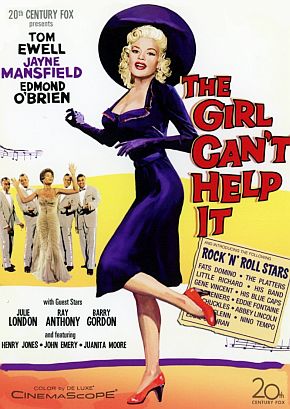
Promotional poster for “The Girl Can’t Help It” (1956), starring Jayne Mansfield and others, but also featuring Fats Domino & other music groups. Click for DVD.
Music Player
“Blue Monday” – Fats Domino
“Blue Monday” is a song originally written by Dave Bartholomew, and first recorded by Smiley Lewis in 1954. Domino and Bartholomew share the songwriting credit for the 1956 version sampled above, which became a No. 1 R&B hit for 8 weeks and also a No. 5 hit on the pop charts. The saxophone solo is by Herb Hardesty.
During the mid- and late-1950s, a spate of rock ’n roll comedy-drama type films like The Girl Can’t Help It, flourished briefly, helping to bring exposure to various rock ’n roll performers, including Fats Domino, Bill Haley, Little Richard, Eddie Cochran, and others. Domino also appeared in a second rock music film, Shake, Rattle, and Rock!, released in April 1957. It starred a young Mike Connors (later of Manix TV detective fame) and featured, among other artists, Domino on piano. Fats played three songs in the film – “I’m in Love Again,” “Honey Chile” and “Ain’t That a Shame.” (Among other rock ’n roll entrepreneurs of that day venturing into rock music films was Cleveland radio disc jockey Alan Freed, who figures prominently in the early history of bridging R&B music to more mainstream audiences, and helping, in fact, to name the music “rock ’n roll.” Between 1956 and 1959 Freed was involved with several of these films, first with performers such as Bill Haley, Chuck Berry and others, and later with Frankie Lymon, and before they became stars, actresses Valerie Harper and Tuesday Weld).
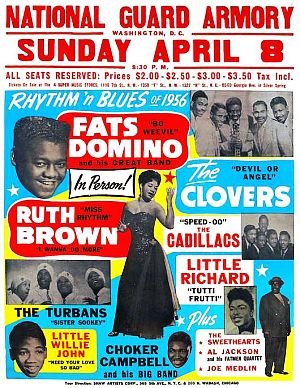
Poster for April 1956 rhythm & blues show at Wash., DC National Guard Armory, with Fats Domino among featured headliners. Click for similar poster.
“As Big as Elvis”
In 1956-57, Fats Domino, in terms of record sales, was neck-and-neck with Elvis Presley. With a string of hits, including “Blue Monday” and “I’m Walkin,” Domino was at the peak of his popularity, selling “a million records a month,” by one count.
The February 1957 issue of Ebony magazine had a feature story on Domino with a cover tagline: “Fats Domino: King of Rock ’n’ Roll. ” Inside the magazine, the story ran for five pages, hitting all the highlights of his stardom and popularity, noting he was then receiving up to $2,500 a night to perform, had fifty suits and 100 pairs of shoes, along with a $1,500 diamond horseshoe stick pin. Ebony also noted that Fats had a 1956 gross income of over $500,000. The magazine piece also included photos of Fats on the road; one with crowds jostling to beat the fire marshal’s audience limit; and another showing whites and blacks mixing at his performances.
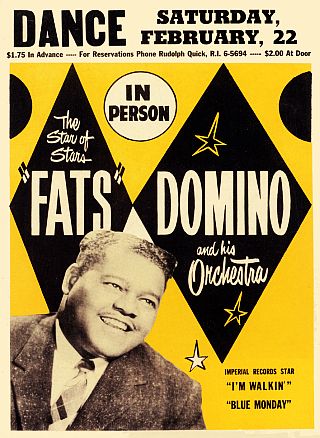
Poster for Fats Domino performance and dance, likely late 1950s, featuring “I’m Walkin” and “Blue Monday”. Click for poster.
On the Road
During 1957, Fats Domino was in great demand, and he and his band hit the road for non-stop touring, doing shows all across the country.
In fact, during 1957, the Domino band traveled 13,000 miles across the U.S. performing more than 350 shows, selling out nightclubs and concert halls.
Yet, despite being one of the most popular rock ‘n’ roll bands in the country, with a sizable number of white fans, Domino and his band encountered racial segregation in many locations. As they toured, they were denied access to lodging, food and services, and were forced to use “colored only” facilities. Sometimes they would travel 100 miles or more out of their way to find a rooming house.
In the late 1950s, among TV venues where Fats appeared was Dick Clark’s American Bandstand show. On December 18, 1957, Domino’s hit recording of “The Big Beat” was featured on Clark’s American Bandstand show. Then on March 29, 1958, on The Dick Clark Saturday Night Beech-Nut Show, Fats and band performed a medley of his songs that included: “I’m In Love Again,” “Blueberry Hill,” “Ain’t That A Shame,” and “I’m Walkin.” Clark had introduced Fats that evening by noting at that point that Fats (then slated to perform at the Apollo that week in New York) had sold some 25 million recordings –“a pretty fantastic thing in the short length of time the man has been in the business,” said Clark at the time. A YouTube video of Clark’s introduction and Domino’s medley (in a rough black-and-white kinescope video of that day) shows the performance as well as the Bandstand-era crowd of white teens clapping and singing along with Domino’s performance.
“Walking To…”
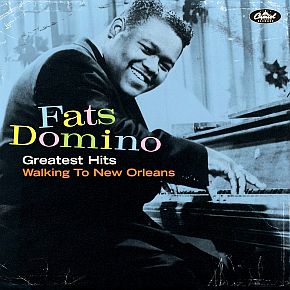
A 2007 Capitol Records album of Fats Domino Greatest Hits, featuring “Walking to New Orleans”. Click for digital.
Music Player
Fats Domino – “Walking to New Orleans”
The idea for the song came to Charles from a conversation he had with Fats when Fats had come to Lafayette, Louisiana, saying that if he were to visit Fats in New Orleans he’d have to walk there since he didn’t have a car. The idea of walking to New Orleans stayed with Charles for a time and he would soon dash off a version of the song for Domino in 15-minutes. The final song was later arranged by Dave Bartholomew and Fats in the studio, and it also incorporated strings, then an unusual addition to a rock song. It went on to be one of Domino’s biggest hits, released on Imperial Records in June 1960 and hitting No.6 on the pop charts and No.2 on the R&B chart.
Fats continued his touring through the early 1960s, appearing sometimes at college and university venues, as in the February 1962 appearance shown below at Franklin & Marshall College in Lancaster, Pennsylvania.

February 1962: Fats Domino at the piano performing before a crowd of mostly white students at Franklin & Marshall College in Lancaster, Pennsylvania.
But by the early 1960s, things started to cool off for Fats Domino. After a decade of hits and popular acclaim, other musical genres and artists began to move into the spotlight. Fats also had a change of record company at that time, and the listening tastes of the trend-setting young record buyers was changing as well. But Fats continued to record. In the 1962-1964 period, for example, he released a variety of songs, among them: ‘Jambalaya’, ‘You Win Again’ and ‘Your Cheating Heart’ – the latter tune his take on a Hank Williams song. He also did covers of other material, including,‘I Hear You Knocking’, ‘You Always Hurt The One You Love,’ and ‘Goin’ Home.’ And he also had some of his own new releases – ‘My Real Name’, ‘Dance With Mr Domino’ and ‘Did You Ever See A Dream Walking.’ Fats’ albums, meanwhile, continued to be strong sellers.

Cover art for the record jacket of Fats Domino’s 1963 single, “Red Sails in The Sunset.” Click for digital.
One single he released with ABC was “Red Sails in the Sunset,” an old song, first published in 1935. The music for the original version was written by Hugh Williams (Wilhelm Grosz) with lyrics by songwriter Jimmy Kennedy. Initially, the song was inspired by the “red sails” of Kitty of Coleraine, a yacht Kennedy often saw off the coast of Portstewart, Ireland, where he wrote the song. Early versions of this song included one by Guy Lombardo in 1935, and another by Nat King Cole in 1951. But Fats Domino’s 1963 cover of “Red Sails in The Sunset,” became a No. 35 hit in October 1963. It would be his last Top 40 Billboard hit, but not the end of his career by any means.
Beatles’ Visit
When the Beatles came to New Orleans in September 1964 on their U.S. concert tour they wanted to visit with Fats Domino. The Beatles, shown below with Fats, were quite taken with his music, which had been an influence in their formative years. Domino’s 1956 song, “I’m In Love Again,” was the first “rock ‘n roll” song that George Harrison heard. “Ain’t That A Shame” was the first song that John Lennon learned to play.

1964: Fats Domino with the Beatles – from left, Ringo Starr, Paul McCartney, George Harrison, Fats Domino and John Lennon – having a little jam session...
In 1967, Beatles’ manager Brian Epstein was able to bring Fats and his band to England for the first time. In one review of the performance there, The Record Mirror raved that Fats “completely and utterly enraptured a thrilled audience with his warm, happy brand of New Orleans rock, blues or whatever you care to call it. His voice was superb, his piano playing exciting, and his nine-piece band inspired.”

Fats Domino in a German advertisement featuring “Lady Madonna” and 1968 album, “Fats Is Back.” Click for CD.
Music Player
Fats Domino – “Lady Madonna”
Jann Wenner, the founder of Rolling Stone magazine, reviewed Domino’s album, calling it “unequivocally a fine record in all respects.” And specifically of the “Lady Madonna” track, Wenner noted the Domino version was “surely as good a cover of a Beatles’ song as ever has been done…”.
In the 1970s-1980s, Domino traveled the world, often making yearly tours in Europe, where he became something of an icon. A 1979 album, Sleeping on the Job, became a minor European hit. In 1980 Fats appeared in Clint Eastwood’s hit movie, Any Which Way You Can, performing “Whiskey Heaven” in a cowboy hat, a song which became a small country hit. By the 1980s, however, Domino became less and less inclined to leave his beloved New Orleans, as the demands of touring becoming less appealing, with Fats not always able to find the food and lifestyle he liked on the road. Still, for the next 20 years, Fats toured internationally off and on, performing his hits at sold-out shows around the world in his trademarked boogie woogie style. And until his final public performance in 2006, his old friends and musical colleagues, among them, Dave Bartholomew, Herb Hardesty, and Lee Allen, were often in the band.
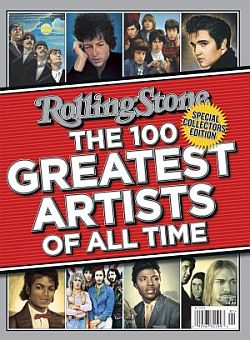
Rolling Stone ranked Fats Domino 25th on list of “100 Greatest Artists of All Time.” Click for copy.
Kudos for Fats
By the mid-1980s, various music awards and honors would begin rolling in for Fats Domino. In 1986, he was one of the first ten inductees into the Rock and Roll Hall of Fame, joining Elvis Presley, Chuck Berry, Little Richard, Buddy Holly, Jerry Lee Lewis, Sam Cooke, James Brown, Ray Charles and the Everly Brothers. At the induction ceremony, Billy Joel lauded Fats for proving “the piano was a rock and roll instrument.”
The following year, Domino received the Grammy Lifetime Achievement Award. But Fats was still taking his music on the road occasionally, even in the 1990s when he toured Europe a couple of times, though exhaustion cut one of those trips short.
More awards, meanwhile, came Domino’s way in his later years. In March 1995, he received the Rhythm & Blues Foundation’s Ray Charles Lifetime Achievement Award in Los Angeles.
In 1998, President Bill Clinton awarded Domino a National Medal of Arts. But Domino by this time is such a New Orleans homebody that he sent daughter Antoinette to receive the award. In 2004, Fats Domino is ranked No.25 on Rolling Stone magazine’s list of the “100 Greatest Artists of All Time.” In August 2005, during Hurricane Katrina, Fats Domino was rescued from his heavily flooded home in New Orleans 9th ward – where some thought he had perished during the storm.
In 2007, the double CD album, Goin’ Home: A Tribute to Fats Domino, was released, featuring covers of Domino songs by John Lennon, Paul McCartney, Tom Petty, Elton John, Robert Plant, Norah Jones, Allen Toussaint, Buddy Guy, Doctor John, Robbie Robertson, Randy Newman, Neil Young, Willie Nelson, among others. On May 19, 2007, at age 79, Fats Domino performed publicly for the last time at Tipitina’s in New Orleans. A year earlier, Fats had released the album, Alive and Kickin, to benefit Tipitina’s Foundation, which supports indigent local musicians. That album includes unreleased Fats Domino recordings from the 1990s.
On Domino’s 88th birthday in February 2016, PBS’ American Masters series aired the TV documentary, “Fats Domino and the Birth of Rock ‘n’ Roll.” On August 21, 2016, at a ceremony held in Detroit, Michigan, Domino was inducted into the Rhythm & Blues Hall of Fame, along with Dionne Warwick, Cathy Hughes, Smokey Robinson, Prince and The Supremes.
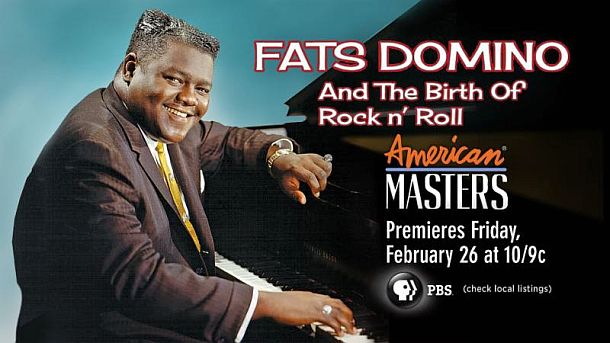
In February 2016, in honor of his 88th birthday, the Public Broadcasting System’s (PBS) American Masters TV series, aired a one-hour documentary on Fats Domino, covering much of his life & career during the 1950s-1960s. Click for DVD.
Music critics the world over have praised Domino’s historic contributions to rock ’n roll and R&B music. By the end of his career, Domino was credited with selling more records than any other 1950s rock ‘n roll artists except Elvis Presley. And in one interesting bow to Domino’s significance occurring in July 1969, Domino was one of 2,200 people who attended Presley’s first concert at the Las Vegas Hilton. At a press conference following that show, a journalist referred to Presley as “The King.” However, Presley gestured toward Domino, who was in the room. “No,” Presley said, “[there’s] the real king of rock and roll.”
For additional stories at this website on music history, song profiles, and artist biographies, see the “Annals of Music” page. See also the topics page, “Pop Music, 1950s: Artists, Songs, Bios,” for additional stories from the 1950s era. Thanks for visiting – and if you like what you find here, please make a donation to help support the research, writing and continued publication of this website. Thank you. – Jack Doyle
|
Please Support Thank You |
____________________________________
Date Posted: 20 March 2017
Last Update: 6 January 2021
Comments to: jdoyle@pophistorydig.com
Article Citation:
Jack Doyle, “Fats Domino: 1950s-2000s,”
PopHistoryDig.com, March 20, 2017.
____________________________________
Sources, Links & Additional Information
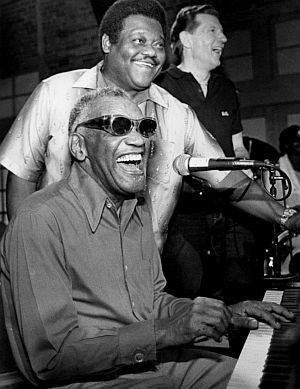 Three great piano artists: Ray Charles, Fats Domino and Jerry Lee Lewis around June 1986 when they recorded the TV concert, “Cinemax Sessions: Fats Domino and Friends.” |
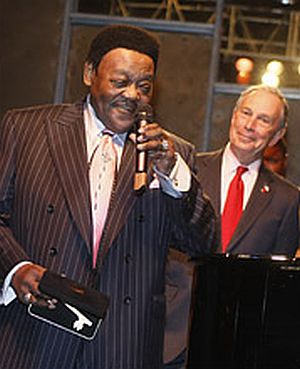 Nov 2007: Fats Domino and New York Mayor Michael Bloomberg at the Pink Elephant club in New York where Fats was honored and awarded the key to the city. |
“Fats Domino,” in Holly George-Warren and Patricia Romanowski (eds), The Rolling Stone Encyclopedia of Rock & Roll, Rolling Stone Press, New York, 3rd Edition, 2001, pp. 274-275.
PBS / American Masters Series, Fats Domino and The Birth of Rock ‘n’ Roll, February 2016, Directed by Joe Lauro.
Rick Coleman, “Fats Domino: Timeline of His Life, Hits and Career Highlights,” PBS.org/ American Masters, January 26, 2016.
“Fats Domino Biography,” Rock ‘n Roll Hall of Fame.
“Fats Domino,” Wikipedia.org.
“King of Rock and Roll: Fats Domino Hailed as New Idol of Teenagers,” Ebony, February 1957, Vol. 12 Issue 4, p. 26.
Robert Christgau, “Consumer Guide” (1990), Village Voice, December 25, 1990.
Rick Coleman, “Seven Decades of Fats Domino,” OffBeat.com, (New Orleans, LA) February 1, 1998.
Rick Coleman, Blue Monday: Fats Domino and the Lost Dawn of Rock ‘n’ Roll, Da Capo Press, April 2006, 416pp.
Larry Engelmann, “Ain’t That a Shame: Thirty Years Ago, America Experienced Its First Rock ‘n’ Roll Riot,” Los Angles Times, July 6, 1986.
“Pat Boone,” Wikipedia.org.
Patrick Doyle, “Inside Rock Legend Fats Domino’s World: Crawfish, Cards, Boogie-Woogie; On His 88th Birthday, the Rock & Roll Architect’s Musical Influence Is Honored in a New Documentary,” Rolling Stone.com, February 26, 2016.
“July 7: Rock and Roll History in San Jose,” LouieLouie.net.
“Walking to New Orleans,” Wikipedia.org.
David Kunian, “What Fats Domino Means to New Orleans,” Off Beat Magazine (New Orleans, LA), April 20, 2015.
“Red Sails in the Sunset (song),” Wikipedia.org.
Gwen Thompkins, Host,“Fats Domino: The Founding Father of Rock ‘n’ Roll,” Music Inside Out, (hour long radio program), WWNO Radio, 89.9 FM, New Orleans.
“Shake, Rattle & Rock! (1956 film),” Wikipedia.org.
Nate Chinennov, “Finding Thrills With the King of ‘Blueberry Hill’,” New York Times, November 10, 2007.
“The Big Beat: The Story of Fats Domino and His Band,” Historic Films Stock Footage Archive
YouTube.com, Dec 2, 2013.
______________________________
